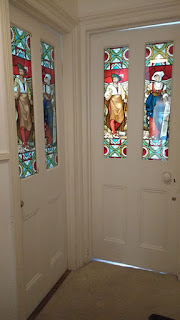With different designs being used across the estate...
Jones, C.S., Mrs., and Williams, Henry
T. Household Elegancies: Suggestions in Household Art and Tasteful Home
Decorations. 4th ed. New York: Henry T. Williams, 1877. "Transparencies on
Glass, Etc.": "Vitremanie": p. 25.
Clean breaks...
leaching...
Fortunately the damage to the panels I was asked to help preserve was not as bad as the badly cracked one above with single and a few multiple cracks but hanging together...
Single (above) and multiple cracks (below).
It seems impossible to find anyone to replace or repair this glass so the best hope was to preserve and protect it by putting 4mm toughened glass into the sight line both sides. Laminate film was also recommended but with the cracks and the water marks it didn't seem a good idea to get water near it (for floating / placing the film). End result the panels will hopefully be secured for many more years...
Transfer glass never achieved the expectations of its early enthusiasts, it never got to provide "a daily word of wisdom that will speak openly to every member of the household on sacred or historic themes, or the beauties of creation". In domestic glass it is relatively rare now and little is still known of the intricacies of the processes. Fortunately there are some great sources of information and if this post has interested you and you would like to find out more check out the excellent article 'The Conservation of Chromolithographic Windows in St Benet's Chapel, Netherton and the Origins of Transfer Printing on Glass' by Mark Bambrough in The BSMGP Journal vol XXXIX. You can order article reprints from the BSMGP here; http://www.bsmgp.org.uk/Publications/.
Thank you Paul Chasse, librarian from the Corning Museum of Glass for researching my request for info and sending a copy of Household Elegancies amongst other fascinating Victorian reference material. What a truly excellent service you provide.
If you live in the area and have any photos of this type of glass or any further information to add please feel free to get in touch and I will post your photos / info at the end of this blog.














No comments:
Post a Comment